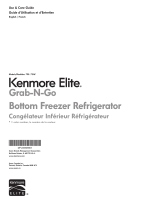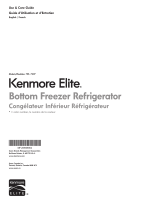
1 -
3 - USING THE APPLIANCE
(continued)
3.9 - WATER DISTRIBUTION
The tank located in the fridge door, enables you to
store water in order to have cool water easily,
without needing to open the fridge.
Use suitable glasses to collect the water under the
distributor by pressing the tab
(Diagram. 3.9.1)
.
Before using the tank for the first time, remove it
from the door, remove the nozzle from the tank and
wash both the nozzle and inside of the tank with
water (the lid can also be removed).
Fill the tank up before replacing it in the door then fill
several glasses to complete the cleaning process.
Warning: Fill the tank up to the maximum level
(quantity suggested on the tank) and do not exceed
the recommended level. Otherwise the tank may
overspill once closed.
If you do not want to use the water tank, you can
remove it and fit the door hole cover 1 instead (avai-
lable in the plastic bag)
(Diagram. 3.9.2)
.
Warning: Do not touch any other part of the
appliance when filling the tank as water could leak.
3.10 - IC
E MAKER
(D
EPENDING ON MODEL
) (Diagram.
3.10.1)
Lhe ice maker enables you to make and store ice
cubes.
To use it:
- remove it from its support
- fill it with drinking water (do not exceed the maxi-
mum level).
- place it back on its support.
Wait for approx. three hours. Once the ice cubes
formed, activate the distributor by turning the but-
ton (or pressing the knob) in order to drop the ice
cubes into the drawer.
Please note: Do not use the ice drawer to make a
bloc of ice.
4 - REGULAR CARE
For hygienic reasons the appliance (including exte-
rior and interior accessories) should be cleaned
regularly at least every two months.
Always unplug the appliance before cleaning.
Electrocution risk!
Before cleaning, switch the appliance off and
unplug it from the mains socket.
Exterior cleaning
To maintain your appliance in good condition, you
should clean it regularly.
Wipe the digital panel and display panel with a
clean, soft cloth.
Spray water onto the cleaning cloth and not directly
onto the appliance. This will avoid any mould from
appearing on its surface.
Clean the doors, handles and cabinet surfaces with
a mild detergent and wipe dry with a soft cloth.
Do not use sharp objects to avoid scratching
the surface of the appliance. Do not use any
thinners, car detergents, Clorox, ethereal oils, abra-
sive cleansers or organic solvents such as benzene
for cleaning. They may damage the surface of the
appliance and may cause fire.
Interior cleaning
You should clean the appliance interior regularly.
Wipe the inside of the fridge-freezer with a weak
solution of water and bicarbonate of soda, then
rinse with warm water using a wrung-out sponge or
cloth. Wipe completely dry before replacing the
shelves and racks.
Thoroughly dry all surfaces and removable parts.
Although this appliance automatically defrosts, a
layer of frost may occur on the freezer compart-
ment's interior walls if the freezer door is opened
frequently or kept open too long.
1- Remove all food and accessories from the com-
partment, unplug the appliance from the mains
power and leave the doors open. Ventilate the room
thoroughly to accelerate the thawing process.
2- Once defrosted, clean the freezer as described
above.
Do not use any sharp objects to remove frost
from the freezer compartment. Once the
interior dried, plug the appliance back in and switch
it back on.
Door seals cleaning
Make sure to regularly clean door seals.
These can indeed remain stuck by food or beverage
residue and tear off when opening the door. Clean
the seal with a mild detergent and warm water.
Rinse and dry thoroughly after cleaning.
Once the door seals are completely dry,
switch the appliance back on.
Replacing the LED light:
The LED light must not be replaced by the user! If
the LED light is damaged, contact the after sales
department.
22
EN




















